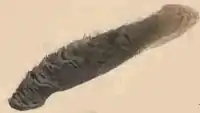| Coleophora ledi | |
|---|---|
 | |
| Scientific classification | |
| Domain: | Eukaryota |
| Kingdom: | Animalia |
| Phylum: | Arthropoda |
| Class: | Insecta |
| Order: | Lepidoptera |
| Family: | Coleophoridae |
| Genus: | Coleophora |
| Species: | C. ledi |
| Binomial name | |
| Coleophora ledi Stainton, 1860[1] | |
Coleophora ledi is a moth of the family Coleophoridae. It is found from Fennoscandia and northern Russia to the Pyrenees and the Alps. In the east, it ranges to Japan. Outside of Eurasia, it is known from North America where it is found in eastern Canada, Michigan, and Alaska.



The wingspan is 10–13 mm (0.39–0.51 in).[2]
The larvae feed on Ledum palustre, Ledum groenlandicum and Chamaedaphne calyculata. They create a strongly curved lobe case. Some very large leaf fragments are found in the central part.[3] Young larvae overwinter in small cases. When feeding and larval growth are resumed in early spring, the larvae enlarge their cases by adding a series of rings of leaf epidermis with pieces sticking out on all sides. They make underside mines that are easily detected as large brown blotches visible from the upper surface of the leaves. The larvae mature in late April and early May feeding on the previous year's foliage. The adults emerge in early to mid-May and are possibly diurnal.[4]
References
- ↑ Fauna Europaea
- ↑ Japanese Moths
- ↑ "Coleophora ledi". Plant Parasites of Europe. Retrieved 10 August 2020.
- ↑ Systematics Of The Nearctic Species Of Metallic-Green Coleophora (Lepidoptera: Coleophoridae)